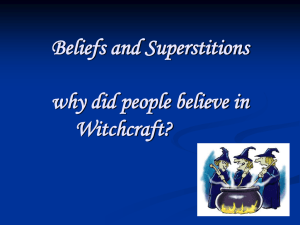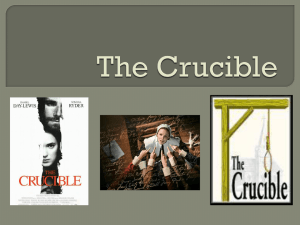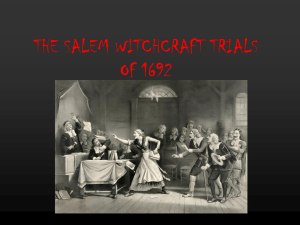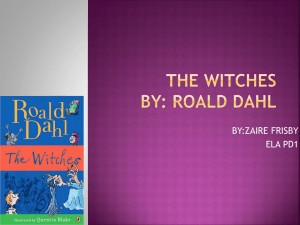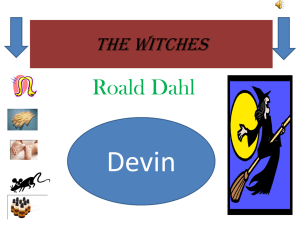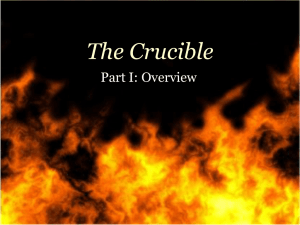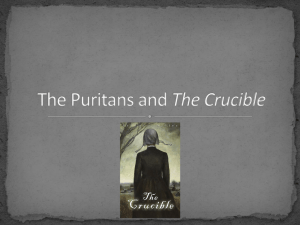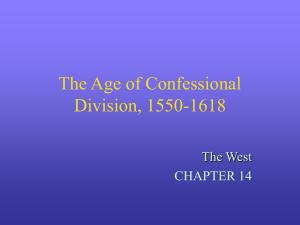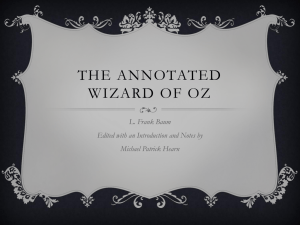Witchcraft History
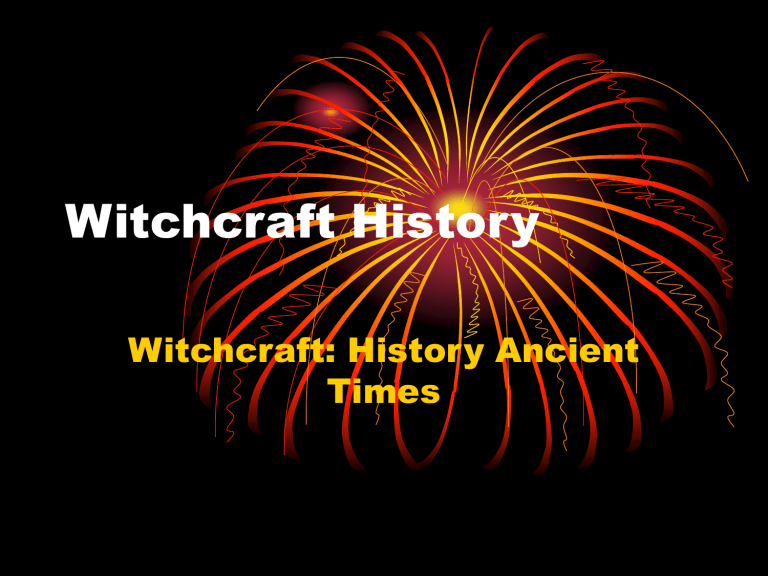
Witchcraft History
Witchcraft: History Ancient
Times
Witchcraft as sorcery has existed since humans first banded together in groups.
Prehistoric art depicts magical rites to ensure successful hunting.
Western beliefs about witchcraft as sorcery grew out of the mythologies and folklore of ancient peoples, especially the Greeks and
Romans.
When Christianity began to spread, witchcraft came to be linked with worship of the Devil.
In Europe, beginning about A.D. 700, witchcraft was increasingly associated with heresy (rejection of church teachings).
• The Christian church began a long campaign to stamp out heresy.
• Beginning in the 1000’s, religious leaders sentenced heretics to death by burning.
• The Inquisition, which began about 1230, was an effort by the church to seek out and punish heretics and force them to change their beliefs.
Eventually, the secular (non-religious) courts as well as all Christian churches were involved in the persecution of witches.
Especially after the 1500’s, most people accused of witchcraft came to trial in secular courts.
The witch hunt reached its peak in Europe during the late 1500’s and early 1600’s.
Many victims, who were mostly women, were falsely accused of witchcraft.
Many accused witches were tortured until they confessed and then faced imprisonment, banishment, or execution.
• In American Colonies, a small number of accused witches were persecuted in New
England from the mid 1600’s to the early
1700’s.
• The most famous witch hunt began in
1692 in Salem, Mass., where a group of village girls became fascinated with the occult.
• The girls began to act strangely, uttering weird sounds and screaming.
• Suspicions that witches were responsible for the girls’ behavior led to the arrest of three women, with more arrests to follow.
• Thus, mass trials were held and nearly 150 people were imprisoned on witchcraft charges.
Nineteen men and women were convicted and hanged as witches.
Anyone who refused to plead either innocent or guilty to the witchcraft charge was pressed to death with large stones!
Ten Theories of Witchcraft
The "theories" for the causes of the Witch
Hunts listed below are drawn from what various historians have suggested.
They are called theories, because they are based on reasonable information (or were, when they were first proposed), and make some sense in explaining the phenomena.
No one explanation or theory will suffice to explain all Witch Hunts in Europe from
1400 to 1800.
To understand the Witch Hunts in their totality, we must keep all of the theories in mind, and even look for more still.
1. Illness Theories
– These are variously related to physical and mental conditions of people involved in the hunts.
– According to one theory, peasants went a little wacky, becoming clinically neurotic and even psychotic, and in a group panic went after the witches.
– According to another theory credence given to children’s fantasies and psychosomatic illnesses are some sources for the panic.
– Yet another theory suggests suggests syphilis or ergotism (caused by mold on rotten bread) as causes for mental instability.
– Similarly, a final theory suggests that the effects of consuming bad mushrooms, herbs like deadly nightshade or henbane, or bufotenine from the skin of some toads could have affected people’s minds.
2. The Geographic Origins Theories:
– The Witch Hunts originated in specific locations, for example first in mountainous regions of the Alps and Pyrenees.
– Economic differentiation between regions which were normally self-sufficient suddenly caught in new competition because of the commercial revolution should also be considered.
3. The Greed Theory:
– Elites initiated the hunts in order to confiscate property of others.
4. The Religious Rebellion Theories:
– These theories are of two kinds:
– A. First, the Satanic Religious Rebellion
Theory:
Devil worship actually existed, in particular as a subversive attack on the ruling Christian order.
– B. Second, the Pagan Religious Rebellion
Theory:
Certain forms of worship from the ancient world continued through the
Early Modern period and was misinterpreted by the Christian hunters as Satanic.
5. The Confessional Conflict Theory:
– Reformation and its resultant fights between
Protestants (mainly Lutherans, Calvinists and
Anabaptists, as well as Anglicans) and Roman
Catholics led each to use witchcraft to attack one another.
6. The Disaster Theory:
– As actual misfortunes struck (plague, famine, war, storm), people blamed supernatural forces and found scapegoats in witches.
7. The (Mistaken) Conspiracy
Theory:
– In the Late Middle Ages, religious elites created a new, and mistaken, intellectual framework out of Christian heresy and theology concerning demons.
– They linked the idea of witches to an imagined organized sect which was a danger to the Christian commonwealth.
– Thus authorities sincerely believed in and acted against this Satanic threat, even though it did not really exist.
8. The Social Control or State-building
Theory:
– Early modern governments exploited the fear of witchcraft in order to centralize authority, increase bureaucratic jurisdiction, impose cultural uniformity, and dominate the Church.
– The Church Oppression Theory, popular in the
19th century but held by few today, according to which the Church fraudulently invented witches so as to crush its opponents and grow rich.
9. The Social Functionalist or Social
Accusations Theory:
– Witch accusers acted on a psychological need to blame others for their own personal problems.
– Supporters of this theory argue that witch hunts were therapeutically beneficial for society, since they defined what was right and wrong and rid society of its troublesome marginalized folk, like the old and the poor.
10. The Misogyny Theory:
– The Witch Hunts embodied a social hostility toward women.
– Such theories are often tied with popularizing feminist writers, who might also see in witchcraft a source of empowerment for women.
– The majority of accused and executed were female, yet also old, living alone (whether widowed or spinster), and poor.
Ten Common Errors and Myths about the Witch Hunts
• Corrected and Commented by Brian A. Pavlac,
Ph.D., Professor of History
• #1. The Witch Hunts were an example of medieval cruelty and barbarism.
– FACT: While frequently cruel, the Witch
Hunts took place after the Middle Ages and were conducted by civilized people.
• #2. The Church was to blame for the
Witch Hunts.
– FACT: While Christianity clearly created the framework for the Witch Hunts, no single "Church" was to blame, and many secular governments hunted witches for essentially non-religious reasons.
– During the Middle Ages, the predominant
Christian view of witchcraft was that it was an illusion.
– People might think they were witches, but they were fooling themselves, or the Devil was fooling them.
– Most authorities thought that witchcraft could do no serious harm, because it was not real.
•
Ultimately in 1484, Pope Innocent
VIII, in his
Summis desiderantes
, let the Inquisition pursue witches.
• #3. The Witch Hunts specifically targeted women.
– FACT: While many witch hunters explicitly went after women, very often men fell victim to the witch hunts.
– Men were often accused of being witches, and executed for it.
• #4. The Witch Hunts were an attempt at
"femicide" or "gendercide," meaning the persecution of the female sex, equivalent to genocide.
– FACT: The necessity for women to be involved in procreation of our species prevented any realistic approach toward genocide.
• #5. The Witch Hunts are/were all alike.
– FACT: While the Witch Hunts share some essential similarities, they were enormously different depending on time and place.
– Most witch hunts involved government authorities deciding that a problem with witches existed.
– Usually the danger was seen in an organized conspiracy led by the Devil.
– The authorities then pursued an investigation that often included secret informants and torture to acquire information and confessions.
– Finally, convicted witches were often executed.
• #6. Millions of people died because of the
Witch Hunts.
– FACT: While millions of people might have been affected, the best estimates of recent historians range from
50,000 to 200,000 dead.
– The earlier estimates, too often the figure of 9 to 10 million dead is cited, were grossly exaggerated
• #7. People condemned during the
Witch Hunts were burned at the stake.
– FACT: While indeed governments did burn many witches at the stake, most were executed by other means.
– The most common form of execution, though, was hanging.
– Admittedly, burning was important in many of these cases also, since to further protect against any malevolence from the dead witch, authorities often burned the remains afterward.
– Other popular forms of execution for witches included beheading, drowning, and breaking on the wheel.
– Witches were rarely buried alive, boiled alive, impaled, sawed in two, flayed, drawn and quartered, or disemboweled, as other contemporary criminals were.
• #8. During the time of the Witch Hunts, witches actually existed and worked magic.
– FACT: While some people have claimed to be able to work witchcraft, there is no scientific, empirical, reasonable proof that any actual witches existed or that the magic they claimed to perform actually did what it was supposed to do.
– Most of the crimes of witches sprung from the imaginations of the hunters, the ravings of the insane, and the agonies of the tortured.
– Even those who confessed to witchcraft crimes could not prove a cause and effect relationship between their witchcraft and actual events.
• #9. In modern usage, the term "Witch
Hunt" can be applied to any organized persecution of a group of people.
– FACT: While the term "Witch Hunt" does involve persecution of a group, that group may or may not exist in an organized fashion; and the proper use of the term especially requires that the targeted group is not a real threat to society.
– Literally, a "witch hunt" is an organized attempt to identify and eliminate people who are believed to be able to use supernatural powers to harm society.
– The great tragedy of the Witch Hunts is not only was there no conspiracy of witches, but even if there were, they could do no serious harm to society.
• #10. Modern witchcraft/magick/wicca is a direct descendent of those practices done by people during the Witch Hunts of
1400-1800.
– FACT: While modern witches and pagans have tried to resurrect witchcraft activities described by witch hunters, there exists only a very tenuous connection between modern witches and those before 1800.

